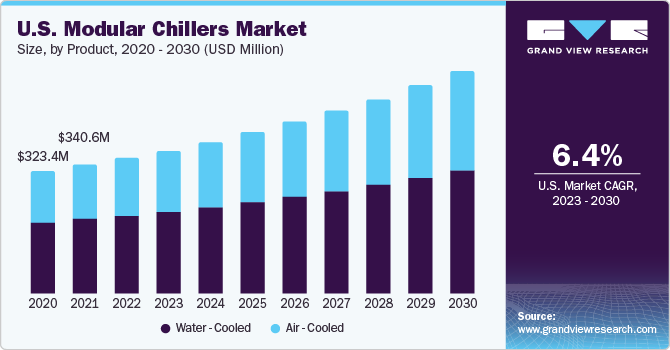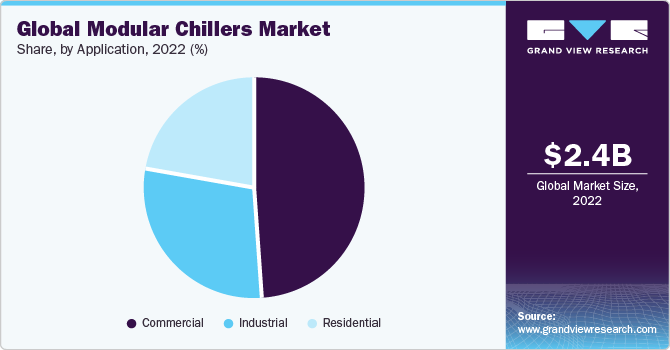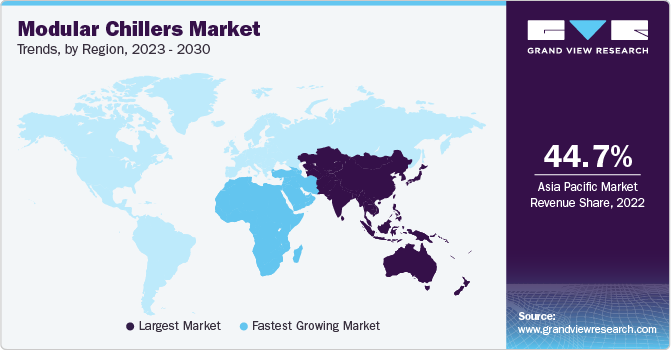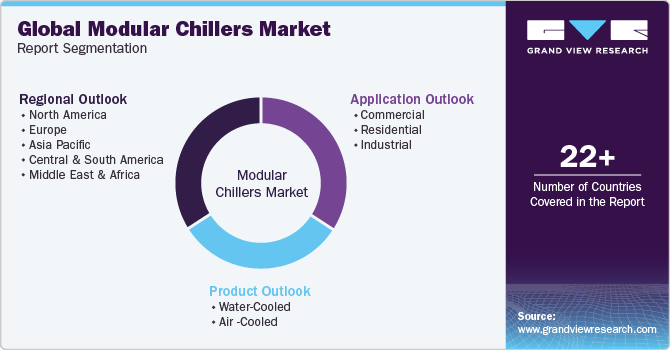- Home
- »
- Advanced Interior Materials
- »
-
Modular Chillers Market Size, Share & Growth Report, 2030GVR Report cover
![Modular Chillers Market Size, Share & Trends Report]()
Modular Chillers Market Size, Share & Trends Analysis Report By Product (Water-cooled, Air-cooled), By Application (Commercial, Residential, Industrial), By Region, And Segment Forecasts, 2023 - 2030
- Report ID: GVR-4-68038-901-2
- Number of Report Pages: 162
- Format: PDF, Horizon Databook
- Historical Range: 2018 - 2021
- Forecast Period: 2023 - 2030
- Industry: Advanced Materials
Modular Chillers Market Size & Trends
The global modular chillers market size was valued at USD 2.42 billion in 2022 and is anticipated to grow at a compound annual growth rate (CAGR) of 6.8% from 2023 to 2030.The growing demand for energy-efficient buildings on account of the rising awareness regarding environmental degradation coupled with stringent government regulations is anticipated to fuel the market growth over the forecast period. Rising awareness about energy-efficient systems and the harmful impacts of burning fossil fuels along with supporting energy-efficient technological innovations is expected to fuel the product demand over the coming years. In addition, tax rebates and financial support for the implementation of energy-saving technologies offered by governments across the globe are anticipated to further stimulate market growth over the forecast period.

The development of privately-owned construction firms in the UAE, India, and China is anticipated to augment the spending in the construction industry over the forecast period. According to the Global Construction 2030 report, the construction industry is estimated to reach USD 15.5 trillion by 2030, with China, India, and the U.S. contributing to over 57% of the overall growth. The growth in the construction industry in the U.S. is more focused on the southern states due to the high population growth.
Several initiatives promoting and encouraging energy efficiency have been adopted and implemented in Europe. For instance, the European Commission’s initiative “The European Portal for Energy Efficiency of Buildings” allows exploration and sharing of knowledge and optimal practices offering energy solutions for buildings.
The water used in a modular chiller needs to be treated or filtered to maintain its quality to prevent fouling. Particulate fouling is caused by suspended solids, including sand, silt, mud, and other particulate matter present in the heat transfer medium. This, in turn, entails regular flushing of the system for the removal of organics and dirt in the system.
Public construction witnessed minimal short-term impact from the COVID-19 pandemic in 2020. Companies have been executing their contracts to avoid liquidation damages. However, the disruption of supply chains in 2020 due to the pandemic resulted in shortages of construction equipment and materials, leading to delays or cancellations of ongoing projects and reduced budgets for future projects.
Modular chillers are increasingly used in the commercial, residential, and industrial industries. The rising construction investment as a result of strong industrial and economic development, along with the increasing population, is expected to boost demand for global modular chillers throughout the forecast period.
The growing demand for non-residential constructions has resulted in a number of ongoing and prospective development projects. The rise in construction investment can be attributed to increased government programs aimed at revamping infrastructure and developing energy-efficient dwellings, which has resulted in greater construction activity. The growing number of residential and public development projects is predicted to stimulate demand for modular chillers.
Modular chiller systems are expected to grow significantly during the forecast period due to their numerous advantages, which include compact design, ability to be installed in existing structures, expandability, high efficiency, flexibility, and coordinated microcontroller control for adjusting the energy utilization of each compressor individually. Furthermore, modular chillers compliance with ASHRAE Standard 15 mechanical ventilation regulations contributes to their eco-friendliness.
The construction activity around the world is expected to contribute to higher energy consumption The World Green Building Council (World GBC) and the International Energy Agency (IEA) are two of the most important organizations working on green building principles and advising builders on energy-efficient designs. Favorable government policies and rising consumer awareness are projected to continue to drive the market throughout the forecast period.
Several efforts to promote and encourage energy efficiency have been devised and implemented throughout Europe. The European Commission’s program “The European Portal for Energy Efficiency of Buildings,” for example, promotes the investigation and exchange of information and best practices for building energy efficiency. The growing need for energy-efficient buildings due to rising environmental consciousness combined with stringent government restrictions is predicted to drive demand for modular chillers over the forecast period.
Water is used extensively in industrial processes for manufacturing and other tasks. Agriculture, oil and gas, paper and pulp, and food and beverage all require water for diverse activities. The requirement for high-quality water for the operation and cleaning of brazed plate heat exchangers in modular chillers to prevent scaling, clogging, and fouling is likely to hinder the market growth.
Product Insights
The water-cooled segment accounted for the largest revenue share of 62.4% in 2022. However, the demand for water-cooled chillers is witnessing sluggish growth on account of the requirement of critical maintenance including freeze protection, mechanical tower maintenance, chiller condenser-tube cleaning, and water treatment. Furthermore, the chillers using open cooling towers are required to have a water treatment program for preventing contaminants such as algae and bacteria.
The air-cooled segment is expected to experience the fastest CAGR of 9.2% during the forecast period. This growth is primarily attributed to their low cost, which is a result of the absence of condenser water pumps and cooling towers. The condensing temperature of air-cooled modular chillers is dependent on the ambient dry-bulb temperature. These chillers are widely used due to their lower maintenance costs, easy installation and design, and high efficiency even at freezing temperatures, when compared to water-cooled chillers.
Application Insights
The commercial segment accounted for the largest revenue share of 48.8% in 2022 and is expected to grow at the fastest CAGR of 7.3% during the forecast period. Modular chillers are used in healthcare facilities, including clinics, retirement homes, and hospitals, to provide cooling to these buildings. These facilities deal with a large number of people having health-related problems and these buildings contain a lot of equipment generating heat. Thus, rising awareness regarding the benefits of chillers along with increasing demand for cooling infrastructure is anticipated to augment the demand over the coming years.

Historical buildings, such as churches, museums, and state capital buildings, often do not have proper air conditioning, or the existing systems are obsolete. The presence of small doorways, thick walls, etc. makes it difficult to install a completely new air conditioning system. Hence, modular chillers are considered for installation in such a building owing to their compact design.
The residential sector is anticipated to grow at a CAGR of 5.9% over the forecast period. This growth can be attributed to the compact design of chillers, which allows for easy transportation through limited spaces, such as stairwells, hallways, and doorways. Modular chillers are becoming a popular choice as they offer a viable alternative to centralized air conditioning systems, fulfilling the necessary cooling demands of various structures.
Modular chillers are also used for transferring heat from the feed throat of injection molding machines, thermometers (mold temperature controllers), and hydraulic heat exchangers. In addition, in the printing industry, these systems cool the paper after it comes out of the ink drying ovens. These systems are used to cool the power supplies and lasers in light projection and laser cutting facilities.
Regional Insights
Asia Pacific dominated the market and accounted for the largest revenue share of 44.7% in 2022 and is expected to grow at the fastest CAGR of 7.7% during the forecast period. The Asia Pacific construction sector is predicted to increase as a result of rising per capita income, rapid urbanization, and a growing population. The economies in the area are likely to thrive throughout the forecast period as a result of substantial government expenditures in the development of public infrastructure and the expansion of the residential construction sector, which is predicted to boost the Asia Pacific modular chillers market.

China’s industrial sector is one of the greatest users of heat. Chemicals, papermaking, pharmaceuticals, textiles, iron and steel, and machine tooling require heat as the major energy input, which is likely to boost demand for cooling equipment, and thereby fueling the demand for modular chillers, throughout the forecast period.
Middle East & Africa is anticipated to grow at a significant CAGR of 6.8% during the forecast period. The increased emphasis of Middle Eastern governments on decreasing their dependency on the energy industry, as well as expanding measures to raise domestic manufacturing output in the petrochemical, chemical, and other industrial sectors, are predicted to increase the need for cooling equipment.
The fast expansion of transportation infrastructure in the country is predicted to increase residential and commercial development in surrounding areas, which will have a favorable influence on product demand throughout the projection period. The construction sector is being driven by factors such as increased tourism, population expansion, and urbanization. The expansion of the construction sector is expected to drive demand for modular chillers in Saudi Arabia throughout the projected period.
Key Companies & Market Share Insights
Mergers & acquisitions, new product launches, and licensing agreements are a few of the strategies adopted by the market players to strengthen their positions in the market. Some prominent players in the global modular chillers market include:
-
Trane Technologies plc
-
GREE ELECTRIC APPLIANCES, INC.
-
Carrier
-
FRIGEL FIRENZE S.p.A.
-
Midea Group
-
Multistack International Limited.
-
Daikin
-
Johnson Controls
-
Haier Group
-
Mitsubishi Electric Corporation
Recent Developments
-
In July 2023, AIREDALE INTERNATIONAL AIR CONDITIONING LTD. unveiled its commitment to building a sustainable future by introducing the MultiChil heat pump chiller line. This new series of cooling solutions features a modular and free-cooling design with low-GWP (Global Warming Potential) properties, aligning with the company's ongoing efforts to promote environmental responsibility and energy efficiency.
-
In July 2023, MODINE MANUFACTURING COMPANY made a significant announcement regarding the acquisition of Napps Technology. As part of this acquisition, MODINE acquired the Jetson product line from Napps Technology. The Jetson product line includes a wide range of cooling solutions, such as water-cooled condensing units, modular air-cooled and water-cooled chillers, air-cooled chillers, and packaged air-cooled chillers split-systems. This strategic move reinforces MODINE's position in the market and expands its portfolio of cooling products.
-
In May 2023, Johnson Controls unveiled a state-of-the-art engineering center and laboratory site, dedicated to developing and testing cutting-edge innovations in intelligent, healthy, and eco-friendly building technologies. The facility will house 250 employees, with a strong focus on engineering and technology, working together to drive advancements in the industry. The property's owner and developer, Weas Development, will lease the space to Johnson Controls, with construction expected to be completed by late 2024. This strategic move underscores Johnson Controls' commitment to creating a sustainable and efficient future for buildings and their occupants.
-
In February 2023, AIREDALE INTERNATIONAL AIR CONDITIONING LTD. unveiled a pioneering series of chillers and heat pumps designed to cater to the comfort market with reduced GWP (Global Warming Potential). The SpiraChillTM and iChillTM product lines mark the first two innovations in this new lineup from AIREDALE. These cutting-edge offerings include both heat pump and cooling-only options, harnessing the power of scroll and inverter screw technologies to deliver impressive cooling and/or heating capacities ranging from 200kW to 1400kW. Additionally, customers can choose from partial and/or full heat recovery options, making them more energy-efficient and environmentally friendly choices.
-
In February 2023, LG strengthened its position in the global HVAC market during the AHR Expo 2023. The company showcased an impressive array of cutting-edge solutions at the HVAC Solution booth, introducing several new offerings for the year 2023. Among the highlights were indoor air quality solutions, high-efficiency heat pumps, Variable Refrigerant Flow (VRF) systems, and versatile building automation and connection products. LG's presence at the expo demonstrated its commitment to innovation and its dedication to meeting the evolving needs of the HVAC industry.
Modular Chillers Market Report Scope
Report Attribute
Details
Market size value in 2023
USD 2.57 billion
Revenue forecast in 2030
USD 4.11 billion
Growth rate
CAGR of 6.8% from 2023 to 2030
Base year for estimation
2022
Historical data
2018 - 2021
Forecast period
2023 - 2030
Quantitative units
Revenue in USD million/billion and CAGR from 2023 to 2030
Report coverage
Revenue forecast, company ranking, competitive landscape, growth factors, and trends
Segments covered
Product, application, region
Regional scope
North America; Europe; Asia Pacific; Central & South America; MEA
Country scope
U.S.; Canada; Mexico; Germany; UK; France; Italy; Russia; Spain; China; India; Japan; South Korea; Thailand; Indonesia; Malaysia; Australia; Brazil; Argentina; Saudi Arabia; UAE; South Africa
Key companies profiled
Trane Technologies plc; GREE ELECTRIC APPLIANCES, INC.; Carrier; FRIGEL FIRENZE S.p.A.; Midea Group; Multistack International Limited.; Daikin; Johnson Controls; Haier Group; Mitsubishi Electric Corporation
Customization scope
Free report customization (equivalent up to 8 analyst’s working days) with purchase. Addition or alteration to country, regional & segment scope
Pricing and purchase options
Avail customized purchase options to meet your exact research needs. Explore purchase options
Global Modular Chillers Market Report Segmentation
This report forecasts revenue growth at global, regional, and country levels and provides an analysis of the latest industry trends in each of the sub-segments from 2018 to 2030. For this study, Grand View Research has segmented the global modular chillers market based on product, application, and region:

-
Product Outlook (Revenue, USD Million, 2018 - 2030)
-
Water-Cooled
-
<50kW
-
51-100kW
-
101-200kW
-
201-300kW
-
>301kW
-
-
Air-Cooled
-
<50kW
-
51-100kW
-
101-200kW
-
201-300kW
-
>301kW
-
-
-
Application Outlook (Revenue, USD Million, 2018 - 2030)
-
Commercial
-
Corporate Offices
-
Data Centers
-
Public Buildings
-
Mercantile & Service
-
Healthcare
-
Others
-
-
Residential
-
Industrial
-
Chemical
-
Food & Beverage
-
Metal Manufacturing & Machining
-
Medical & Pharmaceutical
-
Plastics
-
Others
-
-
-
Regional Outlook (Revenue, USD Million, 2018 - 2030)
-
North America
-
U.S.
-
Canada
-
Mexico
-
-
Europe
-
Germany
-
UK
-
France
-
Italy
-
Russia
-
Spain
-
-
Asia Pacific
-
China
-
India
-
Japan
-
South Korea
-
Thailand
-
Indonesia
-
Malaysia
-
Australia
-
-
Central & South America
-
Brazil
-
Argentina
-
-
Middle East & Africa
-
Saudi Arabia
-
UAE
-
South Africa
-
-
Frequently Asked Questions About This Report
b. The global modular chillers market size was estimated at USD 2.42 billion in 2022 and is expected to reach USD 2.57 billion in 2023.
b. The modular chillers market, in terms of revenue, is expected to grow at a compound annual growth rate of 6.8% from 2023 to 2030 to reach USD 4.11 billion by 2030.
b. The Asia Pacific dominated the modular chillers market with a revenue share of 44.7% in 2022, on account of the rapid urbanization, coupled with growing populations in several countries including China and India.
b. Some of the key players operating in the modular chillers market include Trane Technologies plc, Gree Electric Appliances, Inc., Carrier, Frigel, Midea Group, Multistack International Limited, McQuay Air-Conditioning Ltd. (Daikin), Johnson Controls-Hitachi Air Conditioning, Haier Group, Mitsubishi Electric Corporation.
b. The key factors driving the modular chillers market include growth in the construction industry, increasing demand for compact cooling equipment in the HVAC & refrigeration industry, rising demand for energy-efficient solutions, and favorable government regulations.
Share this report with your colleague or friend.
![gvr icn]()
NEED A CUSTOM REPORT?
We can customize every report - free of charge - including purchasing stand-alone sections or country-level reports, as well as offer affordable discounts for start-ups & universities. Contact us now
![Certified Icon]()
We are GDPR and CCPA compliant! Your transaction & personal information is safe and secure. For more details, please read our privacy policy.
We are committed towards customer satisfaction, and quality service.
"The quality of research they have done for us has been excellent."





